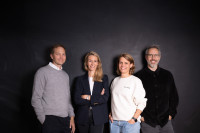The Paradoxical Consumer in the Experience Economy
200 Zeichen Lorem ipsum dolor sit amet, consectetuer adipiscing elit. Aenean commodo ligula eget dolor. Aenean massa. Cum sociis natoque penatibus et magnis dis parturient montes, nascetur ridiculus mus. Donec quu.
Kim Notz

Consumers and their desires are never free of contradictions—because people are more than just buyers of industrial products. They are part of cultures and communities. Today’s consumers are more digitally immersed than ever before, yet at the same time they long for meaningful experiences in the analog world. A paradox—or simply two sides of the same coin?
An entire economic sector has now grown around experiences: the Experience Economy. The term was coined by B. Joseph Pine II and James H. Gilmore more than 25 years ago. They identified experiences as a distinct economic category—separate from services, products, and undifferentiated commodities. The more interchangeable products and services become, the more the experience takes center stage. Only a premium experience can justify a premium price.
Lorem ipsum dolor sit amet, adipiscing elit.
Today, almost every experience has both components—digital and analog. Consumers now expect the same standards from brand experiences online as they do offline. The real art lies in bringing both together seamlessly, so that these paradoxical consumers encounter a consistent brand journey. It’s no coincidence that agencies once known purely for events now find themselves at the very heart of brand work. One example is the AVANTGARDE Group, whose CEO Marc Schumacher I spoke with in episode #107.
The agency was founded in 1985 by Martin Schnaack, who stepped down in late 2022 after 37 years at the helm, handing leadership over to Schumacher. Since 2019, a majority stake has been held by private equity investor EMH Partners. Today, AVANTGARDE has grown into a group of 850 people and several subsidiaries, including the digital agency Slash.Digital, Trendbüro, and CAYA—a boutique agency in Amsterdam specializing in what Schumacher likes to call “cultural intelligence.”
Few Brands Have True Communities
Culture—or rather, cultures—are always there before a brand enters the picture. Cultures and subcultures manifest in communities, and at best, brands can contribute to them: enriching a culture or community rather than creating one from scratch. This flips a widely held assumption on its head: that brands somehow “own” their own communities. In some cases that may be true, but even a premium brand like Porsche doesn’t run most Porsche clubs itself. Those groups are created by people who are fascinated by the brand and its products. Communities organize themselves.
Marketing, however, has inflated the term “community” to the point of meaninglessness. Today, Facebook fans, newsletter subscribers, or loyalty-card holders are often labeled as part of a brand community. For Marc Schumacher, “community” has become one of the biggest marketing buzzwords of the past two or three years. In his view, very few brands will succeed in becoming the true center of a community. Instead, he argues for what he calls “community matching”: identifying strong, existing communities where a brand can add value.
Lorem ipsum dolor sit amet, adipiscing elit.
Questions like these go far beyond staging a brand in physical spaces. Today, the customer journey is almost always a hybrid of analog and digital touchpoints. But how many brands truly manage every touchpoint well enough to create a consistent brand experience?
A common weakness—shared by both online and offline players—is an excessive focus on transactions. Performance marketing, for instance, is often stretched to the breaking point, optimized down to the last percentage, at the expense of brand and experience. Likewise, in brick-and-mortar retail, storytelling and staging too often take a back seat to immediate sales.
The Cathedrals of the Brand
ronically, Apple achieves record sales per square meter in its stores—precisely because of the way it stages its brand and delivers an outstanding customer experience. For Marc Schumacher, these stores are the cathedrals of Apple in the offline journey. As a digital luxury brand offering physical products, Apple occupies a unique position: both an aspirational model for many and a textbook example of excellence. It is also the world’s most valuable brand leader in the Experience Economy.
This exceptional customer experience arises from the seamless interplay of retail—both online and offline—physical products, the software ecosystem, and services. Apple customers are willing to pay premium prices precisely for this level of excellence. Many other brands, however, struggle with imbalance: while they invest heavily in media communication, the moment a customer picks up the phone, they often find themselves trapped in the service nightmare.
Lorem ipsum dolor sit amet, adipiscing elit.
Of course, not every brand can build Apple-like stores. Start-ups and digital players, in particular, often struggle with physical retail. This is where a relatively new concept has gained traction in recent years: Retail as a Service. Instead of investing in their own stores and building the necessary expertise, brands can rent space in existing retail locations, benefiting from the know-how and experience of the brick-and-mortar world.
Here, too, the focus is on the experience: consumers should be able to see, touch, and try products. Where the actual transaction happens is secondary—products are often shipped directly to the customer’s home. Retail as a Service isn’t limited to pop-up stores; it can encompass a brand’s entire presence in physical retail and online. AVANTGARDE, through its subsidiary nonplusultra acquired two years ago, has established its own Retail-as-a-Service agency, connecting brands and retailers from strategy development through to execution.
Consumers need physical spaces
Marc Schumacher does not join the chorus declaring the death of brick-and-mortar retail—Galeria Karstadt Kaufhof being the poster child of such narratives. In the podcast, he cites figures from North America, where the number of physical stores reached an all-time high last year. And this despite the ongoing growth of e-commerce, which, despite temporary dips in sales, is expected to continue steadily in the medium to long term once the current crisis-driven pullback in consumer spending has passed.
Lorem ipsum dolor sit amet, adipiscing elit.
Focusing on the decline of outdated retail concepts often overlooks how much is happening in areas like brand spaces or showrooms. These stores are intelligently integrated into the customer journey, with the actual transaction often taking place elsewhere—online, for example. Brick-and-mortar retail needs to move beyond its fixation on transactions and embrace the paradigm of the Experience Economy.
People still visit city centers, not necessarily to buy something, but to have an experience. Paradoxical, hyper-digitized consumers need physical spaces to engage with brands and products—and with other people, think communities. That’s why Marc Schumacher is convinced that in ten years, the significance of places like Munich’s Viktualienmarkt or Hamburg’s Isemarkt will be even greater than it is today.
Find more here:
Kontakt





